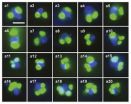(Press-News.org) LA JOLLA, CA – January 20, 2011 – Scientists at The Scripps Research Institute have found that a known enzyme in cells protects against measles virus, likely by altering the virus's genetic material, RNA. Cells lacking the enzyme become highly vulnerable to the virus's destructive effects. The enzyme also protects against several other respiratory viruses, including influenza A.
"We believe that host cells use this RNA-editing enzyme to slow these viruses' ability to replicate," said Michael B. A. Oldstone, the study's senior author and a professor at Scripps Research's La Jolla, California campus. The study's first authors are Simone V. Ward, a senior research associate in the Scripps Research Oldstone laboratory, and Cyril X. George of the University of California, Santa Barbara.
The finding represents a significant improvement in the understanding of measles infections, which still kill about 150,000 children and adults around the world every year. The paper, which was published recently in Proceedings of the National Academy of Sciences, has prompted commentaries in the journals Nature Reviews Microbiology and Viruses.
The focus of the study was the enzyme ADAR1 ("adenosine deaminase acting on RNA, 1"), which is known to be produced in high amounts in measles-infected cells. ADAR1 has been suspected as a "restriction factor" that inhibits viral replication.
ADAR1's role against measles has been difficult to nail down, however. In mice genetically engineered to be infectable by measles – a virus that normally infects only humans – ADAR1 is required for embryonic development, as in all mice. Thus the standard "gene knockout" technique, which would enable scientists to see how measles infections proceed without ADAR1, hasn't been feasible.
In this study, Ward, George, and Oldstone, and their colleagues knocked out only one of the two forms of ADAR1 produced in cells. This form, p150, is the one produced in response to infections. For reasons that still aren't clear, mouse embryos cannot grow for long without p150, so the researchers used a standard technique to "immortalize" these p150-knockout embryonic cells—ensuring their continuous supply—and in this way created a useful cell model.
When infected by measles virus, the p150-knockout cells succumbed quickly compared to immortalized control cells that produced p150 normally. "When I looked at the cells only 21 hours after infection, the p150-knockout cells already showed the signs of cell damage typical of measles infection," said Ward. "But the control cells looked exactly like uninfected cells."
In further tests, Ward found p150 also provided significant protection for cells against Newcastle disease virus, Sendai virus, canine distemper virus, and influenza A virus – which are all respiratory viruses like measles, and all members of the paramyxovirus or orthomyxovirus families.
Nine years ago, it was reported that a cellular enzyme known as APOBEC3G protects cells from DNA-based viruses such as HIV, by mutating viral genes. "We're now showing that an analogous gene-editing enzyme also seems to exist for RNA viruses," said Oldstone.
With the new cell model, and advanced "conditional knockout" techniques that allow genes to be disrupted in specific organs in adult mice, Ward, Oldstone, and their colleagues now hope to study ADAR1-p150's role in more detail.
One key issue to be resolved is the enzyme's role during brain infections. Measles virus usually results in a relatively mild illness lasting only a week or two, but in rare cases it spreads to the brain and becomes a persistent, always fatal infection known as subacute sclerosing panencephalitis (SSPE). In such cases, the virus doesn't have to spread via cell-to-cell contact, thus exposing itself to the immune system; it can spread more stealthily along the axons and dendrites that connect neurons.
"What we hope to show with our ongoing work is that host neurons are using ADAR1 to slow down this process, turning it into a gradual neurological disease," said Oldstone. ADAR1 might also be exacerbating the neurological symptoms of SSPE, he adds, because its enzymatic activity is known to affect the production of the important neurotransmitter receptors for serotonin and glutamate: "It's an enzyme that has multiple roles," Oldstone concluded.
###
In addition to Ward and Oldstone, authors of the paper, "RNA editing enzyme adenosine deaminase is a restriction factor for controlling measles virus replication that also is required for embryogenesis," are, Megan J. Welch, Li-Ying Liou, Juan C. de la Torre, and Hanna Lewicki of Scripps Research; Bumsuk Hahm of Scripps Research and the University of Missouri; and Cyril X. George and Charles E. Samuel of the University of California, Santa Barbara. For more information, see http://www.pnas.org/content/108/1/331.abstract
The work was supported by grants from the National Institutes of Health.
About The Scripps Research Institute
The Scripps Research Institute is one of the world's largest independent, non-profit biomedical research organizations, at the forefront of basic biomedical science that seeks to comprehend the most fundamental processes of life. Scripps Research is internationally recognized for its discoveries in immunology, molecular and cellular biology, chemistry, neurosciences, autoimmune, cardiovascular, and infectious diseases, and synthetic vaccine development. An institution that evolved from the Scripps Metabolic Clinic founded by philanthropist Ellen Browning Scripps in 1924, Scripps Research currently employs approximately 3,000 scientists, postdoctoral fellows, scientific and other technicians, doctoral degree graduate students, and administrative and technical support personnel. Headquartered in La Jolla, California, the institute also includes Scripps Florida, whose researchers focus on basic biomedical science, drug discovery, and technology development. Scripps Florida is located in Jupiter, Florida. For more information, see www.scripps.edu
END
Stanford, CA— Genghis Khan and his Mongol hordes had an impact on the global carbon cycle as big as today's annual demand for gasoline. The Black Death, on the other hand, came and went too quickly for it to cause much of a blip in the global carbon budget. Dwarfing both of these events, however, has been the historical trend towards increasing deforestation, which over centuries has released vast amounts of carbon dioxide into the atmosphere, as crop and pasture lands expanded to feed growing human populations. Even Genghis Kahn couldn't stop it for long.
"It's a common ...
WASHINGTON, Jan. 20 – The eyes of moths, which allow them to see well at night, are also covered with a water-repellent, antireflective coating that makes their eyes among the least reflective surfaces in nature and helps them hide from predators in the dark. Mimicking the moth eye's microstructure, a team of researchers in Japan has created a new film, suitable for mass-production, for covering solar cells that can cut down on the amount of reflected light and help capture more power from the sun.
In a paper appearing in Energy Express (www.OpticsInfoBase.org/ee), a ...
VIDEO:
A two-minute video, "Morphological Change in Machines Accelerates the Evolution of Robust Behavior, " was produced by the Morphology, Evolution and Cognition Laboratory, University of Vermont, 2011.
Click here for more information.
Want to build a really tough robot? Forget about Terminator. Instead, watch a tadpole turn into a frog.
Or at least that's not too far off from what University of Vermont roboticist Josh Bongard has discovered, as he reports ...
AURORA, Colo. (Jan. 20, 2011)--Cancer scientists have designed the first molecular test to predict which bladder cancer patients may have cancer involvement in their lymph nodes at the time of surgery—which could help doctors determine which patients are good candidates for pre-surgical, or neo-adjuvant, chemotherapy.
The test analyzes 20 genes on tumor biopsies, according to a paper published online Jan. 20, 2011, in Lancet Oncology.
"Randomized clinical trials have shown that giving neo-adjuvant chemotherapy extends patient lives, but only 5 to 15 percent of patients ...
In a paper published today in the journal Science, a University of California, Davis, researcher and his co-authors challenge a widely held assumption that plants will move uphill in response to warmer temperatures.
Between 1930 and 2000, instead of colonizing higher elevations to maintain a constant temperature, many California plant species instead moved downhill an average of 260 feet, said Jonathan Greenberg, an assistant project scientist at the UC Davis Center for Spatial Technologies and Remote Sensing.
"While the climate warmed significantly in this period, ...
With little more than a conventional photocopier and transparency film, anyone can build a functional microfluidic chip.
A local Cambridge high school physics teacher invented the process; now, thanks to a new undergraduate teaching lab at Harvard's School of Engineering and Applied Sciences (SEAS), students will be able explore microfluidics and its applications.
The Microfluidics Lab, developed by Dr. Anas Chalah, Director of Instructional Technology at SEAS, takes advantage of a simple but ingenious new method of creating lab-on-a-chip devices that are quick to produce, ...
DETROIT—Wayne State University researchers have found that when patients and providers speak the same language, patients report less confusion and better health care quality. The findings were based on data from the Pew Hispanic Center/Robert Wood Johnson Foundation's Latino Health Survey.
Understanding the relationship between language and health care quality has important public health implications for providing services in an increasingly diverse U.S. population, according to Hector M. González, Ph.D., assistant professor of family medicine and public health at WSU's ...
Breast cancer patients who have a strong social support system in the first year after diagnosis are less likely to die or have a recurrence of cancer, according to new research from Vanderbilt-Ingram Cancer Center (VICC) and the Shanghai Institute of Preventive Medicine. The study, led by first author Meira Epplein, Ph.D., assistant professor of Medicine at VICC, was published in a recent edition of the Journal of Clinical Oncology.
Patients in the study were enrolled in the Shanghai Breast Cancer Survivor Study, a large, population-based review of female breast cancer ...
A team of biologists has discovered an entirely new group of algae living in a variety of marine and freshwater environments. This group of algae, which the researchers dubbed "rappemonads," have DNA that is distinctly different from that of other known algae. In fact, humans and mushrooms are more closely related to each other than rappemonads are to some other common algae (such as green algae). Based on their DNA analysis, the researchers believe that they have discovered not just a new species or genus, but a potentially large and novel group of microorganisms.
The ...
New research reveals that a hormone best known for stimulating the production of red blood cells can modulate the immune response. The study, published by Cell Press in the January 27th issue of the journal Immunity, finds that erythropoietin (EPO) has contrasting influences on infectious and inflammatory diseases and may be useful in the design of new therapeutic strategies.
EPO is a cytokine hormone that stimulates the production of red blood cells by acting at EPO receptors (EPORs) on red blood cell precursors. Interestingly, other cell types also express EPORs. ...



